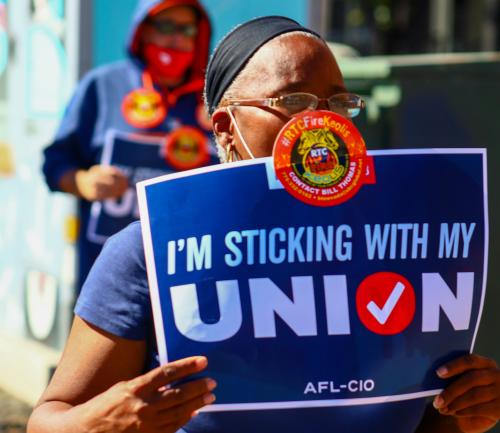Shareholders also won concessions in exchange for removing proxy access proposals.
Shareholders in the United States advocating so-called ‘proxy access’ are virtually certain to continue pressing for the controversial new rules next year, after winning a small but significant portion of votes at annual meetings this past spring. They also wrung significant governance concessions out of several other companies in exchange for withdrawing proposals prior to the meetings.
Long reviled by many corporate boards, proxy access would force companies to list shareholder-nominated board candidates in their proxy materials – a potentially potent cudgel for activist shareholders looking to bend management to their will. Currently, dissident shareholders must shoulder the often prohibitive cost of paying for their own proxy materials if they wish to challenge management’s slate of approved directors, making victory far harder to achieve.
Of the roughly two dozen proxy access proposals originally offered up this year, only two won majority votes. Unlike versions of proposals that failed or that the SEC ruled could be excluded, both contained the same ownership threshold put forth in proxy access rules adopted by federal regulators in 2010 before a court struck them down. These rules would require anyone offering up board candidates to hold 3 percent of company stock for three years.
Both winning proposals were also at companies where investors were so enraged at management – Chesapeake Energy and Nabors Industries – that shareholders likely would have opposed the board on virtually any governance issue on their ballots.
These were not the only victories. A third company, Hewlett Packard (HP), agreed to voluntarily put the issue to a vote on its 2013 ballot, after a shareholder proposal that would have forced the issue appeared to have strong support.
Another firm, KSW, voluntarily adopted a 5 percent, one-year ownership requirement, while Pioneer Natural Resources agreed to adopt majority board voting and sponsored a proposal to declassify its board, in exchange for a removal of the proxy access proposal from its ballot.
Uncertain ramifications
Corporate governance experts disagree on the long-term significance of the votes. Skeptics have seized on the fact that many proposals were either excluded from the ballot or failed to garner majority support.
‘The jury is way out at this point’ on whether proxy access will survive as an issue, says Charles Nathan, of counsel for Latham & Watkins. ‘This only proves what people already knew – that shareholders were already very unhappy with the two companies for what they perceived as massive failures of governance. You had two poster children, and poster children in our world get tagged.’
Shareholder advocates disagree. ‘These are watershed events,’ argues Amy Borrus, deputy director of the Council of Institutional Investors. ‘This is a signal to corporate America that proxy access is now part of the governance landscape. The Chamber of Commerce and other company groups fought proxy access for years with warnings about what a disaster it would be, and guess what? The sky didn’t fall.’
Proxy access, Borrus predicts, ‘is going to be kind of like say on pay – you will see more support because investors will get more comfortable with it.’
At the outset of the 2012 proxy season, both sides predicted that this would be an ‘experimental’ year, as advocates tested the reactions of large shareholders and the SEC to different forms of proxy access proposals and refined their message for future campaigns. In other words, this year was more about drawing the battle lines – the years ahead will be about fighting the battles.
This strategy was necessitated by recent regulatory changes and legal rulings. In 2010, the SEC issued a new proxy access rule that would have required companies to list shareholder-nominated board candidates in their proxy materials if those nominating directors owned 3 percent of the company for three years.
In July 2011, a federal appeals court struck that rule down but left in place another new SEC revision that for the first time allowed shareholders to use company proxy materials to propose their own board election and nomination procedures. Rule 14a-8 left the door open for shareholders themselves to force the board to adopt proxy access laws.
Try, try again
This year there were three different high-profile versions of proxy access filed by shareholders at a total of 22 different firms. The US Proxy Exchange advocated the most aggressive and most widely offered version. It called for ‘crowd access’, a concept which in its most common form would have allowed 100 or more investors, each holding at least $2,000 in company stock for one year, to band together and nominate directors. It would also have allowed shareholders owning 1 percent for two years to offer candidates.
Another variation of this proposal called for 50 investors for two years.
This type of proposal was offered up at Goldman Sachs, Dell, Chiquita Brands International, Bank of America and Ferro, among others. At some companies the SEC granted no-action relief, ruling that the proposal constituted more than one proposal or was vague and indefinite. At others the proposal was voted down by relatively wide margins – it won just 13.5 percent at Ferro, for instance.
Norges Bank, Norway’s central bank, pushed a second approach for at least six companies that also went beyond the SEC’s original 3 percent rule. This version – filed at CME Group, Charles Schwab, Pioneer Natural Resources, Staples, Wells Fargo and Western Union – also failed to garner any majority support. It would have allowed those with 1 percent ownership for at least one year to elect up to 25 percent of company directors.
US labor and pension funds authored the version that won at Nabors and Chesapeake (and which was withdrawn before a vote at HP). Their language mirrored that in the original SEC rules – 3 percent for three years, with a 25 percent limit to board seats.
Many industry players say they expect further deliberate experimentation with various forms of proxy access next year, but this year clearly shows that ‘if people tee up the SEC proposal as a shareholder proposal – 3 percent for three years – it has a decent chance of passing,’ according to Patrick Quick, a partner at Foley & Lardner who specializes in corporate governance and proxy statements.
‘If you look at those that came to a vote, those were the only two that have come to a vote that had those parameters,’ Quick continues. As a result, Borrus agrees, the proposals are likely to be more widespread on proxy ballots next year.
Non-binding proposals
Francis Byrd, leader of Laurel Hill Advisory Group’s corporate governance/risk advisory practice, points out that the winning proposals were also non-binding. Most of the failed Norges Bank proposals were binding and would have amended company bylaws – which, Byrd argues, may well have played a bigger role in the failure of the initiatives than the percent of ownership thresholds.
That fact may, some suggest, prompt some advocates next year to offer non-binding proxy access proposals with lower shareholder thresholds, or 3 percent proposals that are in fact binding.
Even non-binding proposals, however, have significant consequences. In May, three Chesapeake board members were replaced by candidates put forth by the company’s largest shareholder, Southeastern Asset Management, while a fourth was proposed by activist investor Carl Icahn, and the company appointed a new chairman with no previous connection to the company (though certainly proxy access was not the only factor in the shake-up).
Nabors has not yet said what action it will take in response to its June 5 proxy access vote, but if nothing else, companies that fail such non-binding votes ‘will feel extreme heat’ to take action, notes Quick. And if recent experience with say on pay is any guide, that heat may be hard to ignore. After losing non-binding say-on-pay votes in 2011, even the most traditionally reticent boards acceded to shareholder demands and took significant actions to change their compensation practices. The shareholder outcry, it seems, was finally too loud to ignore.
One thing most agree on is that, as Byrd puts it, ‘proxy access proposals are here to stay.’ He argues that this is yet one more reason to reach out to shareholders and make sure there is no need to fear a rebellion. Companies, Byrd says, need to assess the quality of their corporate governance and ‘determine whether they have any problems with shareholders.’
Byrd continues: ‘By problems I mean shareholder proposals that have passed and have been ignored by companies, or underperformance without a plan to address that underperformance, or large and embarrassing executive compensation problems – anything that might bring the company to the attention of the governance advocates.
‘If a company does not have performance problems, doesn’t have governance problems, and has good relationships with the shareholders, this isn’t going to take root. It can only take root where there are governance problems.’
Proxy advisory firms, Byrd notes, are unlikely to support proxy access proposals, and shareholders are unlikely to vote for new guidelines unless they see a record of failure on the part of the board to address governance or performance problems.
‘I don’t think we’re going to see thousands of proxy access proposals,’ Byrd says. ‘I think we will see a few more than we did this year.’
Dodging the bullet
Ron Schneider, senior vice president at AST Phoenix Advisors, says he and his colleagues were advising their clients on how to avoid ending up a target even before the 2012 proxy season began.
‘You want to do an internal review to identify any weaknesses or gaps in your corporate governance, or ‘board story’, before someone else does an external critique of you, and close any identified gaps – including telling investors more about the board,’ Schneider warns. ‘Investors aren’t in the boardroom, so you want to give them a window through disclosure without opening yourself up to microscopic scrutiny.
‘The likely targets will be companies that are already on investors’ radar for perceived deficiencies,’ Schneider continues. Those deficiencies can include failure to enact non-binding approved shareholder proposals such as separating the chair and CEO roles, perceived compensation deficiencies, poor performance, failed say-on-pay votes or even lack of quality disclosure.
‘This was an experimental year, and we fully expect that next year the pool of proponents using this will expand, as will the targets,’ Schneider says. ‘But it won’t be like universal say on pay, where everybody got it all of a sudden. It will probably be like majority voting, where it grows each year – 20 targets this year, maybe 50 next year. We expect it to become increasingly prevalent.’
Brad Robinson, managing director specializing in corporate governance at proxy firm Eagle Rock, says the results this year amount to an extremely small sample size, but notes that even some of those that failed garnered a reasonable amount of shareholder support. At Wells Fargo, for instance, more than 30 percent of voting shareholders supported a Norges 1 percent, one-year proxy access proposal.
‘It’s not exactly a fringe type of proposal,’ Robinson says. ‘Even the US Chamber of Commerce was hoping it would be much less of a big deal going forward. Certainly, companies will have to take this seriously – I think it’s very obvious that proxy access is probably not going to go away soon.’
By granting no-action letters, the SEC has made far clearer what it will and will not accept, and some of the problems are ‘relatively easily remedied’, Robinson notes. That alone means many more companies are likely to see proxy access go to a vote at their annual meetings in 2013.
A review of proxy access votes
The Council of Institutional Investors (CII) has closely monitored proxy access proposals this proxy season. Proponents had submitted 23 proposals to companies, but about half were either omitted by the companies after receiving SEC permission to do so or were withdrawn after a company agreed to adopt governance reforms. Here is CII’s summary of eight proposals that made it to the vote.
• CME Group: submitted by Norges Bank Investment Management, the binding proposal would allow shareowners holding a 1 percent stake for one year access to the company proxy to nominate directors. It received 38 percent of the votes cast
• Charles Schwab: submitted by Norges Bank Investment Management, the binding proposal would allow shareowners holding a 1 percent stake for one year access to the company proxy to nominate directors. It received 31 percent of the votes cast.
• Chesapeake Energy: submitted by the New York City pension funds, the proposal would allow shareowners who have owned at least a 3 percent stake continuously for at least three years to have their director candidates included on the company’s proxy card. It was the second proxy access proposal to receive majority support, garnering 60 percent of the votes cast.
• Ferro: submitted by Ken Steiner, the proposal would allow shareowners with a 1 percent stake for two years access to the company proxy to nominate directors. It received 13.5 percent of the votes cast.
• KSW: submitted by Daniel Rudewicz, the binding proposal would allow shareowners holding a 2 percent stake for one year access to the company proxy to nominate directors. It received 21 percent of the votes cast.
• Nabors Industries: the proposal, which would allow shareowners who have owned at least a 3 percent stake continuously for at least three years to have their director candidates included on the company’s proxy card, was submitted by the New York City pension funds, CalSTRS, the North Carolina Retirement Systems, the Illinois State Board of Investment and Connecticut Retirement Plans and Trust Funds. It was the first access proposal to receive majority support, registering 56 percent of the votes cast.
• Wells Fargo: submitted by Norges Bank Investment Management, the binding proposal would allow shareowners holding a 1 percent stake for one year access to the company proxy to nominate directors. It received 32.5 percent of the votes cast.
• Western Union: submitted by Norges Bank Investment Management, the binding proposal would allow shareowners holding a 1 percent stake for one year access to the company proxy to nominate directors. It received 33.5 percent of the votes cast.








